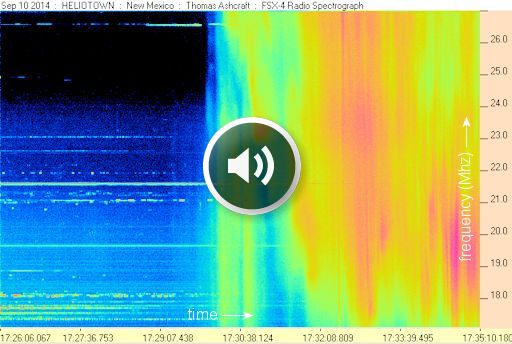New from Spaceweather.com: Edge of Space Advertising. Send your product or message to the edge of space for a down-to-Earth fee. Profits support student space weather research. Email Dr. Tony Phillips for more information. | | | STORM WARNING: A pair of CMEs is heading for Earth. The two solar storm clouds were launched on Sept. 9th and 10th by strong explosions in the magnetic canopy of sunspot AR2158. NOAA forecasters estimate a nearly 80% chance of polar geomagnetic storms on Sept. 12th when the first of the two CMEs arrives. Auroras are in the offing, possibly visible at mid-latitudes before the weekend.. Aurora alerts: text, voice EARTH-DIRECTED X-FLARE AND CME: Sunspot AR2158 erupted on Sept. 10th at 17:46 UT, producing an X1.6-class solar flare. A flash of ultraviolet radiation from the explosion ionized the upper layers of Earth's atmosphere, disturbing HF radio communications for more than an hour. More importantly, the explosion hurled a CME directly toward Earth. The Solar and Heliospheric Observatory photographed the expanding cloud: 
Radio emissions from shock waves at the leading edge of the CME suggest that the cloud tore through the sun's atmosphere at speeds as high as 3750 km/s. That would make this a very fast moving storm, and likely to reach Earth before the weekend. Auroras are definitely in the offing. Stay tuned for a more detailed forecast in the hours ahead. Aurora alerts: text, voice Realtime Aurora Photo Gallery RADIO-LOUD EXPLOSION: The X-flare of Sept 10th caused a radio blackout on Earth. Ironically, it also caused a blast of radio noise. Radio astronomers and hams in the Americas and across the Pacific Ocean heard static roaring from the loudspeakers of their shortwave receivers. "It was absolutely howling," reports Thomas Ashcraft, who sends this 3-minute recording from his amateur radio observatory in rural New Mexico: 
"This is what I heard at the onset of the flare," he explains. "By the time the flare peaked, it became almost too intense for my ears." Advice: Listen to the sound file using stereo headphones. The two channels correspond to two radio frequencies--22 and 23 MHz. Radio emissions like these are caused by shock waves in the sun's atmosphere. Looking at the CME pictured in the news item above, it is easy to imagine how the fast-moving cloud would spawn shock waves in the atmosphere overlying sunspot AR2158. Those shock waves triggered plasma instabilities which, in turn, generated the shortwave radio emissions. More radio bursts may be in the offing. Sunspots AR2157 and AR2158 have unstable magnetic fields that harboor energy for strong explosions. NOAA forecasters estimate a 40% chance of X-class flares and a whopping 85% chance of M-flares on Sept. 11th. Stay tuned. Solar flare alerts: text, voice Realtime Space Weather Photo Gallery
Realtime Sprite Photo Gallery
Realtime Comet Photo Gallery
Realtime NLC Photo Gallery Every night, a network of NASA all-sky cameras scans the skies above the United States for meteoritic fireballs. Automated software maintained by NASA's Meteoroid Environment Office calculates their orbits, velocity, penetration depth in Earth's atmosphere and many other characteristics. Daily results are presented here on Spaceweather.com. On Sep. 10, 2014, the network reported 19 fireballs.
(16 sporadics, 3 September epsilon Perseids)  In this diagram of the inner solar system, all of the fireball orbits intersect at a single point--Earth. The orbits are color-coded by velocity, from slow (red) to fast (blue). [Larger image] [movies] Potentially Hazardous Asteroids ( PHAs) are space rocks larger than approximately 100m that can come closer to Earth than 0.05 AU. None of the known PHAs is on a collision course with our planet, although astronomers are finding new ones all the time. On September 11, 2014 there were potentially hazardous asteroids. Notes: LD means "Lunar Distance." 1 LD = 384,401 km, the distance between Earth and the Moon. 1 LD also equals 0.00256 AU. MAG is the visual magnitude of the asteroid on the date of closest approach. | | The official U.S. government space weather bureau | | | The first place to look for information about sundogs, pillars, rainbows and related phenomena. | | | Researchers call it a "Hubble for the sun." SDO is the most advanced solar observatory ever. | | | 3D views of the sun from NASA's Solar and Terrestrial Relations Observatory | | | Realtime and archival images of the Sun from SOHO. | | | from the NOAA Space Environment Center | | | the underlying science of space weather | | 
